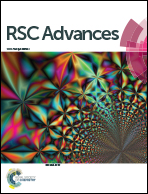Controlled convective self-assembly of silver nanoparticles in volatile organic solvent and its application in electronics†
Abstract
Fabricating functional materials with uniform properties and desired geometries using inorganic nanoparticles could offer us the ability to manufacture nanomaterial-built circuits or devices in a low-cost manner. In this work, we demonstrate a fabrication route combining nanoparticle assembly and sintering to produce uniform coatings and predefined patterns with high conductivity. Homogeneous coatings of monodisperse silver nanoparticles (Ag NPs) were assembled from their dispersion onto flat and non-functionalized substrates by convective self-assembly. The use of dodecylamine-capped 4.5 nm Ag NPs dissolved in chloroform ensures a low sintering temperature and a high evaporation rate. The introduction of a syringe pump in the assembly process expedites the assembly rate in a controlled way as well as improves the surface morphology of the coatings. Heat treatment under facile conditions (200 °C, 15 min, in air) triggers nanoparticle sintering, making the Ag NP coating conductive. By changing experimental parameters, conductive coatings with different thicknesses (200–600 nm) and different conductivities (1–3 × 104 S cm−1) could be produced on Si substrates. Wire bonding and flexible substrate tests show that the conductive coating is suitable for conventional electronics and flexible electronics. Conductive patterns of Ag NPs were fabricated by preparing conductive coatings on a polyimide substrate with laser-engraved patterns. Application of the conductive patterns in electronics was demonstrated by connecting them as flexible electrodes to a magnetic field sensor. This controlled CSA technique expands the competencies of the nanoparticle assembly, in terms of the size of the deposition materials, the range of dispersing solvents, and the scope of potential applications.



 Please wait while we load your content...
Please wait while we load your content...